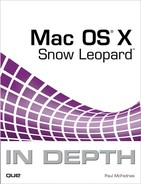18. Wireless Networking with Mac OS X
Networking the Wireless Way
Chapter 17, “Wired Networking with Mac OS X,” was all about wired networking, where each computer and device connects to the network via a cable that runs from the device’s network interface card (NIC) to a port on a switch or router. If you want maximum network speed, Ethernet, particularly Gigabit Ethernet, is the only way to connect.
However, sometimes a wired connection just isn’t practical or even possible. For example, if your switch is in the den, how do you set up a wired connection for the computer in the bedroom next door? One solution is to drill holes in the adjoining walls and then snake a long Ethernet cable through the hole. That will work, but holes in the wall are rarely attractive.
Even more daunting, how do you connect a computer that’s downstairs in the kitchen or even two floors down in the basement? Diehard Ethernet types might consider getting special outdoor Ethernet cables and poking more holes in the appropriate walls, but at some point the hole-making madness must stop. Finally, consider the simple scenario where you’re tired of working in the den and you’d prefer to take your notebook Mac outside to enjoy the sunshine. Do you purchase a 200-foot cable for the privilege of occasionally working away from your desk?
A much more convenient solution in all these scenarios is to forego the cables and go wireless. It’s not as fast as either Fast Ethernet or Gigabit Ethernet, but if you get the right hardware, it’s fast enough, and it means that you can easily and quickly connect almost any computer or wireless device to your network. And wireless signals extend out of doors, so you can go ahead and enjoy the day.
Modern wireless networking can be both fast and reliable, particularly if you build your wireless network around Apple’s AirPort technology, which is the subject of this chapter.
Understanding AirPort
AirPort is Apple’s name for its implementation of IEEE 802.11a/b/g/n wireless standards, which are also the standards for Windows computers and other devices. That’s good news because it means that AirPort devices are compatible with any networks or devices that implement these standards. So, you can use non-Apple devices on AirPort networks and use Airport-equipped Macs on non-AirPort networks as long as those networks comply with the 802.11 standards, which almost all do.
Like Ethernet, there are several flavors of AirPort. There are a number of technical differences between these types, but the most important one is communication speed:
• AirPort—This was the original incarnation and offered many wireless benefits. AirPort communicates at 11Mbps and is compatible with wireless devices based on the 802.11b standard. AirPort is no longer supported by modern Macs, which support AirPort Extreme instead. However, more modern AirPort technologies are backward compatible, so you can connect an AirPort Mac to a network using one of the newer standards and still enjoy its benefits (at a lower speed than the other types, but it works well enough).
• AirPort Extreme—This is the newer standard and offers even more benefits. The first is speed. AirPort Extreme communicates at 54Mbps, which is almost five times the speed at which the original AirPort communicates. AirPort Extreme is compatible with devices using the 802.11g Wi-Fi standard. Second, AirPort Extreme can support more computers at the same time than does AirPort. Third, AirPort Extreme enables you to share a USB printer or hard drive from an AirPort Extreme Base Station. Fourth, with AirPort Extreme, you can wirelessly link base stations together to expand the range of an AirPort network to cover large areas.
• AirPort Extreme 802.11n—This is the newest standard, and it supports the 802.11n specification, which is up to five times faster than 802.11g networks. The newest AirPort Extreme Base Station also has a much larger range than previous models, which is also good news.
Mac OS X supports all flavors of AirPort, but specific Mac models support either AirPort or one of the AirPort Extreme versions; in other words, older Macs can support an AirPort card, whereas all modern Macs support AirPort Extreme cards. The two cards are not interchangeable. To find out which flavor your Mac supports, check its documentation. All shipping Macs support AirPort Extreme.
Note
![]()
Because it is based on the 802.11 standards, AirPort is compatible with 802.11 networks and devices. For example, you can connect an AirPort-equipped Mac to any wireless network that supports 802.11b, 802.11g, or 802.11n devices, such as those designed for Windows computers. Similarly, Windows machines equipped with 802.11b, 802.11g, or 802.11n devices can also access an AirPort network.
Fortunately, even though the hardware for the two standards is different, it is compatible. AirPort machines can connect to AirPort Extreme networks, and vice versa. The primary difference is that AirPort networks are much slower than AirPort Extreme networks are. And, AirPort Extreme Base Stations offer more features than AirPort Base Stations do.
Because it is the newer standard, this chapter focuses mostly on AirPort Extreme. I do my best to use the term AirPort Extreme when discussing something that is specific to AirPort Extreme technology or AirPort Standard when referring to the older technology. When I use the term AirPort, I mean to refer to something that is applicable to both technologies.
AirPort functionality is provided through the following components:
• AirPort-ready Macs—If your Mac is AirPort ready, it has built-in antennas that are used to transmit and receive signals to and from the wireless network. The good news is that all modern Macs are AirPort-compatible and most include an AirPort card as standard equipment.
• AirPort card—To use AirPort, your Mac must have an AirPort card installed in it. If your Mac doesn’t have a card, you can add one inexpensively because AirPort Extreme cards cost only about $49. AirPort cards are simple to install yourself. AirPort cards are standard on all current Macs, except the Mac Pro, which offers an AirPort card as an option.
• AirPort software—The AirPort software is necessary for Macs to communicate through the AirPort hardware. The software to configure and use an AirPort network is part of the standard Mac OS X installation.
Note
![]()
An AirPort Extreme or AirPort Express Base Station and an AirPort-equipped Mac OS X machine sharing its Internet connection are functionally identical from the perspective of providing an Internet connection (though using a dedicated base station offers many benefits). In this chapter, when I use the term base station, it can refer to any of these means of providing an AirPort network. When referring to a specific base station, I’ll use the full name, such as AirPort Express Base Station.
• AirPort Base Station—An AirPort base station transmits the signals for the AirPort network. There are three basic types of base stations. The AirPort Extreme Base Station is a dedicated hardware device that contains ports for a cable or DSL modem, USB printer or hard drive, and up to three Ethernet devices. Another option is an AirPort Express Base Station, which performs a similar function to the full-size base station but doesn’t offer as many features (for example, it has only one Ethernet port to which you connect a cable or DSL modem or a single Ethernet device). You can also configure any AirPort-equipped Mac to act as a base station by using Mac OS X’s built-in Internet sharing capabilities.
An AirPort network provides access to a similar set of services that a wired network does, and the two networks can work together seamlessly. For example, computers connected to a wired network via AirPort can print to printers connected to the base station, use file sharing with Macs connected to the network wirelessly, and so on. If you connect a USB printer to an AirPort Extreme or Express Base Station, you can share that printer with any AirPort-equipped Mac. If you connect a USB hard drive to the USB port on an AirPort Extreme Base Station, you can share that drive with all the computers on the network, whether they connect via a wire or wirelessly.
![]() To learn how to configure file sharing over a network, see “Configuring and Using File Sharing,” p. 364.
To learn how to configure file sharing over a network, see “Configuring and Using File Sharing,” p. 364.
Upgrading with the AirPort Extreme 802.11n Enabler
As mentioned earlier, the latest incarnation of AirPort wireless technology supports 802.11n, and all new Macs that come with AirPort cards support 802.11n. However, many older Macs (even some that are fairly recent) only support 802.11g. How can you tell whether your Mac supports 802.11n? Here’s the easiest way:
1. In Finder, select Applications, Utilities and then launch the Network Utility.
2. In the Network Utility window, select the Info tab.
3. Use the Select a Network Interface for Information pop-up menu to choose your wireless network interface.
The Model value tells you which 802.11 standards your AirPort card supports. In Figure 18.1, for example, this AirPort card only supports up to 802.11g.
Figure 18.1 Use the Network Utility application to see which 802.11 standards your AirPort card supports.
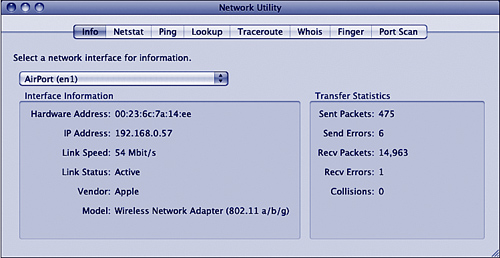
Fortunately, many 802.11g Macs can jump up to 802.11n with a simple software upgrade. If your Mac has an AirPort Extreme card and an Intel Core 2 Duo processor, you can perform the upgrade, which requires a program called AirPort Extreme 802.11n Enabler for Mac. You have two choices:
• If you purchased a new AirPort Extreme 802.11n Base Station, the Enabler is included with the Base Station.
• Purchase the Enabler software from the Apple Store (it costs $1.99): http://store.apple.com/us/product/D4141ZM/A.
Setting Up an AirPort Base Station
Setting up an AirPort base station is slightly different depending on the type of base station you use: an AirPort Extreme or Express Base Station or an AirPort-equipped Mac OS X machine that provides Internet sharing.
There are many benefits to using an AirPort Extreme or Express Base Station to provide a wireless network. One is that they don’t place any processing load on an individual Mac and are intended to run at all times, so the AirPort network is always available. They also provide the ability to share an Internet connection with devices to which they are networked using an Ethernet connection. One of the most important benefits of a base station is that they can shield your network from attack using Network Address Translation. The disadvantage of this device is its cost (currently $179 for an AirPort Extreme Base Station and $99 for an Express Base Station).
The benefit of using an AirPort-equipped Mac OS X machine as a base station is that you don’t need to purchase any additional hardware (except for the AirPort card in the Mac that will act as the base station if it doesn’t already have one). You get most of the functionality from an AirPort base station but don’t have to support another dedicated device. Using this method does have several disadvantages, though. One is that it places additional processing load on the machine that acts as the base station. Another is that the network can be affected by the state of that machine. For example, if the machine is shut down or crashes, the network is taken down as well. Another is that a Mac acting as a base station doesn’t support all the base station’s features, such as the option to wirelessly link base stations together to increase the range of a network. Using an AirPort-equipped Mac isn’t as secure as using a dedicated AirPort base station either.
Note
![]()
You can have multiple base stations operating in the same area at the same time to grow your AirPort network to be quite large.
Setting Up an AirPort Extreme Base Station
Apple’s AirPort Extreme Base Station is a relatively simple device. It contains a transmitter that broadcasts the signal over which the network is provided. It has four Ethernet ports. One, the WAN port, is used to connect to a broadband Internet connection, such as a cable modem. The other three are used to connect to a wired Ethernet network or to Ethernet-equipped devices so the base station can also share its Internet and network connection with the devices connected to it via a network or directly to one of its Ethernet ports. Along with the power adapter port, it offers a USB port to which you can connect a USB printer or USB hard drive to share one of those devices with the network.
Setting up an AirPort Extreme Base Station consists of the following two tasks:
1. Install the base station.
2. Configure the AirPort network, including the Internet connection the base station will use to connect to the Internet.
Installing the Base Station
First, locate the device in a central area so it provides the maximum amount of coverage where you install it. In most houses, the AirPort Extreme Base Station provides adequate signal strength even if you locate it at one end of the house and place machines you want to network at the other end. However, the closer the machines are to the base station, the stronger the signal is.
Of course, a major consideration for the location of the base station is where your Internet connection will come from. If you use a cable modem, you need to locate the device so that you can connect the cable modem to it. If you use a DSL modem, you need to locate the base station relatively close to the phone line port to which the DSL modem is attached.
After you have placed the base station in its location, attach its power adapter to the station and plug it in to a wall outlet. Use an Ethernet cable to connect the cable or DSL modem to the WAN (Wide Area Network) Ethernet port.
You can connect an Ethernet device to each of the three LAN Ethernet ports on the base station. For example, you can connect a network printer, a computer, or to add more than three devices, connect one of the ports to an Ethernet hub.
If you want to share a USB printer with all Macs that can access the network, connect the printer’s USB cable to the USB port on the base station. Likewise, you can connect an USB hard drive to the base station’s USB port to share that drive on the network.
Note
![]()
The machine you use to configure a base station must be AirPort-capable to be able to configure the base station wirelessly. It does not need to have an AirPort card if it is connected to the base station via Ethernet.
Configuring the Base Station
After you have installed the base station, you need to configure it. You can configure it manually through the AirPort Utility, or you can use the guided approach. With either method, you configure the base station from a machine with which it can communicate either via AirPort or through an Ethernet network.
Note
![]()
The specific steps you use to configure a base station with the AirPort Utility depend on what you are doing. For example, you see different options when configuring a base station for the first time than you do when you are reconfiguring a base station. These steps provide an example of reconfiguring an existing base station, but the steps to configure a new one are similar, just in a slightly different order with differences in minor details.
Configuring the Base Station Using the Guided Approach
Use the following steps to configure the base station using the guided approach:
1. Open the AirPort Utility application (Applications/Utilities) to see the first window, which shows all the base stations with which the Mac can communicate (see Figure 18.2).
Figure 18.2 Use the AirPort Utility application to configure AirPort base stations.
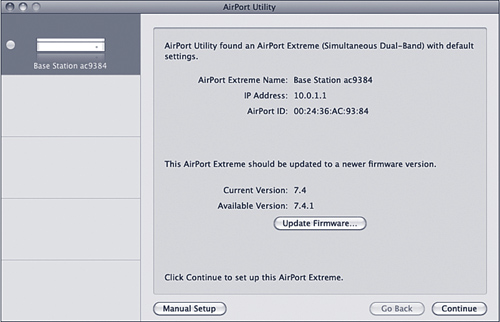
2. Select the base station that you want to configure.
3. If you see a message that your base station firmware should be updated (as shown in Figure 18.2), click Update Firmware and then click Continue in the dialog box that appears. The AirPort Utility downloads and installs the new firmware, and then restarts the base station. When the base station reappears in the AirPort Utility, skip to step 5.
Caution
![]()
If you are configuring a base station that has already been configured and is protected by a password, you have to enter that password before you can proceed.
If the base station you are configuring has outdated software installed on it, the AirPort Utility application attempts to update it. To do so, you must be able to connect to the Internet, which is sort of a Catch-22 in that it assumes that it is already configured and you are reconfiguring it. You can download the update to the Mac you are going to use to configure the base station and then the base station can update its software from there.
4. Click Continue.
5. Type a name for the base station, type the base station password (twice), and then click Continue.
6. Click the I Want to Create a New Wireless Network radio button and click Continue.
7. Enter the name for the wireless network you are creating. This is the name that you’ll select to join a machine to the network.
8. Make sure the WPA/WPA2 Personal radio button is selected, as shown in Figure 18.3, and then type the network password (twice). You must specify a password that’s between 8 and 63 characters long.
Figure 18.3 You should use WPA2 security on an AirPort network.
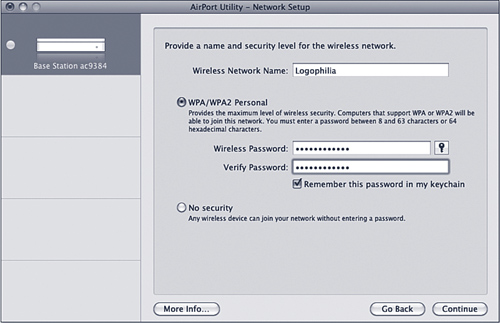
9. Click Continue.
10. If you want to allow Macs and other devices to access the base station’s Internet connection without also having access to your network, leave the Enable Guest Network check box activated, make sure WPA/WPA2 Personal is selected in the Guest Network Security pop-up menu, type the guest network password (twice), and click Continue.
11. Choose the radio button that corresponds to how you connect to the Internet. This is the same method that you’d use if you were connecting your Mac directly to the Internet, as described in Chapter 13, “Connecting Your Mac to the Internet.” Click Continue.
![]() To learn how to configure a Mac for the Internet, see “Connecting Your Mac to the Internet,” p. 267.
To learn how to configure a Mac for the Internet, see “Connecting Your Mac to the Internet,” p. 267.
Note
![]()
If you see an error message stating that the required AirPort hardware was not found when you started the AirPort Setup Assistant, see “No AirPort Hardware Is Found” in the “Troubleshooting” section at the end of this chapter.
If you can’t access the base station because you don’t know the password, see “I Don’t Know the Base Station Password” in the “Troubleshooting” section at the end of this chapter.
12. Enter your Internet connection data, as provided by your ISP, and then click Continue.
13. Click Update and then click Continue. AirPort Utility configures the base station according to the settings you entered. When the process is complete, the base station restarts and the network is available for use.
14. Click Quit.
Configuring a Base Station Manually
You should also know how to manually configure the base station. Manual configuration can be a better and more complete way to configure a base station, and there are some options you can only configure using the manual technique. If you want to change only one aspect of a base station’s configuration, using the manual method is also the way to go. And, it can also be a faster way to configure a base station. For example, you need to manually configure a base station when you want to share an Internet account with other machines on an Ethernet network or to use the AirPort base station as a bridge between the wireless network and a wired one (for example, to allow AirPort-equipped machines to use a printer connected to a wired network). You also use the AirPort Utility application to configure a base station manually by performing the following steps:
1. Open the AirPort Utility (Applications/Utilities). You see all the base stations currently in range of the Mac you are using, whether they can communicate wirelessly or over an Ethernet connection.
2. Select the base station you want to configure and click Manual Setup (if there is only one base station in range, it is selected automatically).
![]() If you get an error message when trying to configure your base station manually, see “I Can’t Configure My Base Station Manually” in the “Troubleshooting” section at the end of this chapter.
If you get an error message when trying to configure your base station manually, see “I Can’t Configure My Base Station Manually” in the “Troubleshooting” section at the end of this chapter.
3. If the base station has been reset, you see a dialog box informing you that the base station has been reset and is not currently configured. (If the base station has not been reset, you won’t have to do this step.) Click Automatic and then authenticate yourself using an administrator name and password. The software reconfigures the base station and restarts it. When it is complete, you return to the Select Base Station window. Click Manual Setup again.
Note
![]()
When you have problems with a base station, sometimes you must reset it so that it returns to its default settings (in effect, you start over).
If new AirPort firmware is available, the application will prompt you to download and install it. Do so and your base station’s firmware will be updated and it will be restarted. You return to the Select Base Station window. Select the base station again and click Manual Setup.
You next see a window that has the base station name as its title that includes several tabs; some tabs also have subtabs (see Figure 18.4).
Figure 18.4 This Manual Setup mode enables you to configure all aspects of a base station.
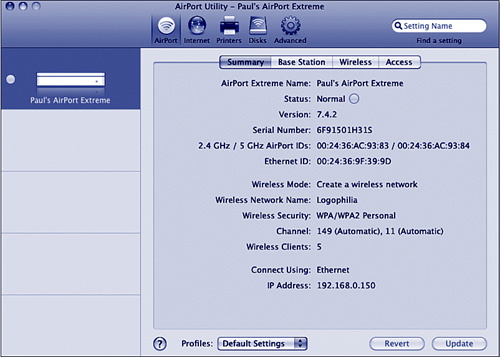
Note
![]()
The tabs you see depend on the type of base station you are configuring. For example, an Extreme Base Station has different options than does an Express Base Station. For example, an Express Base Station has the Music tab, which you can use to configure music broadcast from iTunes. The rest of this information reflects an AirPort Extreme Base Station.
In the manual mode, the AirPort Utility has the following tabs:
• AirPort—Use this tab to configure various aspects of the AirPort network, such as the base station name and wireless network name.
• Internet—With this tab, you determine how the base station connects to the Internet and how it distributes addresses to the other devices on the network.
• Music—On this tab (AirPort Express Base Station only), you configure AirTunes services to broadcast iTunes music to speakers connected to the base station.
• Printers—On this tab, you configure a printer attached to the Base Station.
• Disks—On this tab, you configure a hard disk attached to the Base Station.
• Advanced—While you are unlikely to need to use this tab, you should know in general what it does, which is to enable you to create logs to store messages that can be helpful in diagnosing network problems. You can also configure specific ports on the base station to provide access to devices outside the network. On the third subtab, you can configure PPP dial-in accounts.
Note
![]()
These steps assume the base station you are configuring has been configured previously. If not, the steps might be slightly different.
Covering all these options is beyond the scope of this chapter, but the following steps demonstrate how to configure some of the most common settings.
1. Select the AirPort tab if it isn’t selected already. You see a number of subtabs.
2. Click the Summary tab to see the current configuration of the AirPort network.
3. Click the Base Station tab (see Figure 18.5).
Figure 18.5 Use the Base Station tab to configure the base station name, password, timer server, and whether it can be configured via Ethernet.
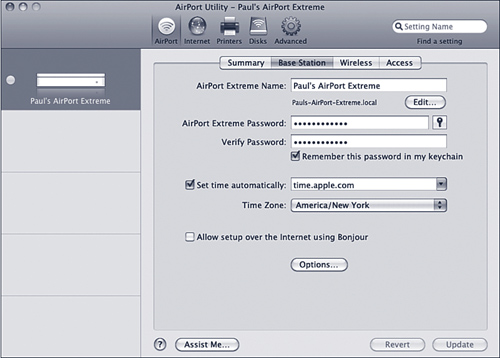
4. Enter the base station name (this is the name of the hardware, not the name of the network it provides) in the AirPort Extreme Name field.
Tip
![]()
To enter the contact information for the base station and its location, click the Options button.
5. To change the base station’s password (not the network’s password), use the AirPort Extreme Password and Verify Password fields and activate the Remember This Password in My Keychain check box.
Note
![]()
If the base station is already providing a network and you change the name or password of the network, people who use the network need to change the network they use. The new network name appears as an available network on the client machines, but you must provide the new password to those whom you want to use the network.
6. To have the base station’s time set automatically, activate the Set Time Automatically check box and choose the time server on the pop-up menu.
7. To allow the base station to be configured over its Ethernet WAN connection, activate the Allow Setup over the Internet Using Bonjour check box.
8. Click the Wireless tab. On this tab, you configure the wireless network being provided by the base station.
9. Use the Wireless Mode pop-up menu to determine if the base station is part of a WDS network.
10. Enter the network name in the Wireless Network Name field.
11. Use the Radio Mode pop-up menu to determine the specific standards supported on the network, such as 802.11b/g compatible.
12. Use the Radio Channel Selection pop-up menu to select the channel over which the base station communicates. Generally, the default channel works fine, but if you are having trouble communicating with devices, you can try different channels to improve signal transmission and reception. If you have multiple AirPort networks in the same area, you can use the Radio Channel Selection pop-up menu to have each network use a different channel so that they don’t interfere with one another.
13. Use the Wireless Security pop-up menu, Wireless Password field, the Verify Password field, and the Remember This Password in My Keychain check box to set the security of the wireless network.
14. Click the Wireless Options button. The Wireless Options sheet appears.
15. Use the Multicast Rate pop-up menu to set the multicast rate. Choosing a higher value improves performance but also reduces range.
16. Use the Transmit Power pop-up menu to change the strength of the base station’s signal. If many base stations exist in the same physical area, reduce the signal strength to limit the interference of these stations with one another. You can also reduce the strength to limit the size of the AirPort network’s coverage, for example, if the base station is in a small space and you don’t want to extend the network past that space.
17. If you want to create a closed network, activate the Create a Closed Network check box. A closed network does not appear on other users’ AirPort menus. To join closed networks, users have to know the name and password for that network (because they can’t see the network on a menu). Using a closed network is a good way to keep your network more secure.
18. Activate the Use Interference Robustness check box to make the AirPort signal less sensitive to interference.
19. Click Done to save your changes and return to the Wireless tab.
20. Click the Internet tab and then the Internet Connection subtab.
21. Configure the base station for Internet access. This works similarly to configuring a Mac for Internet access. Choose the connection method from the Connect Using pop-up menu and then enter the settings you want to use in the lower part of the window. For example, if the Internet connection is provided via a cable or DSL modem using DHCP, choose Ethernet on the Connect Using pop-up menu and Using DHCP on the Configure pop-up menu. Enter the domain name in the Domain name field and a client ID if required.
![]() For a more detailed look at how to configure an AirPort Extreme for the Internet, see “Using an AirPort Extreme Base Station to Share an Internet Connection,” p. 406.
For a more detailed look at how to configure an AirPort Extreme for the Internet, see “Using an AirPort Extreme Base Station to Share an Internet Connection,” p. 406.
Note
![]()
One additional control available for a base station’s Internet access that is not present for a Mac is the WAN Ethernet Port pop-up menu. Use this to set the speed at which the base station communicates with a wired network over its WAN port. In most cases, the Automatic (Default) value is the best choice, but you can choose a specific speed.
22. Click the DHCP subtab to control how the base station provides IP addresses to the network (see Figure 18.6). If you want to use a specific set of IP addresses, use the DHCP Beginning Address and DHCP Ending Address text boxes to enter the starting and ending IP numbers you want to assign. As machines connect to your network, these IP addresses are assigned to each machine that connects (you have to have enough addresses in the range so one is available for each machine).
Figure 18.6 Use the DHCP subtab to configure the IP addresses the base station provides to the network.
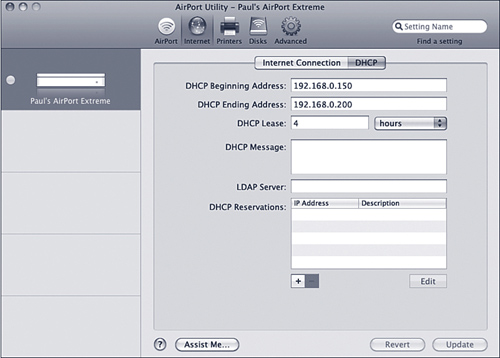
23. Use the DHCP Lease box and pop-up menu to set the number of hours for the DHCP lease on each machine. When this time passes, a new address is assigned to each machine. You can enter a DHCP lease message in the Message box.
Note
![]()
To be able to print to a printer attached to a base station, each computer must have the printer driver installed on it.
24. Click the Printers tab.
25. Enter the name of the printer connected to the base station.
26. When you’re ready to configure the base station, click Update. The base station is configured according to the settings you entered. When the process is complete, the base station restarts and the network is available for use.
Note
![]()
For more detailed information on AirPort, visit Apple’s Knowledge Base at www.apple.com/support/airport.
27. Quit the AirPort Utility.
You can now access the Net and other network services from an AirPort-equipped Mac using the AirPort network. The base station also provides services to a wired network if it is connected to one.
Configuring an AirPort-equipped Mac to Act As a Base Station
As you learned earlier, you can use any AirPort-equipped Mac running Mac OS X to act as a base station. When you do this, the Mac OS X machine provides services similar to those that a dedicated base station provides, but you don’t have as much control over the AirPort network.
To configure a Mac as a base station, perform the following steps:
1. Configure an AirPort-equipped Mac so it can connect to the Internet, for example, through DHCP services provided on an Ethernet network activate the AirPort connection via the Network pane.
![]() To learn how to configure a Mac for the Internet, see “Connecting Your Mac to the Internet,” p. 267.
To learn how to configure a Mac for the Internet, see “Connecting Your Mac to the Internet,” p. 267.
2. Open the Sharing pane of the System Preferences application (see Figure 18.7).
Figure 18.7 You use the controls on the Sharing pane to enable a Mac to share its Internet connection with other computers.
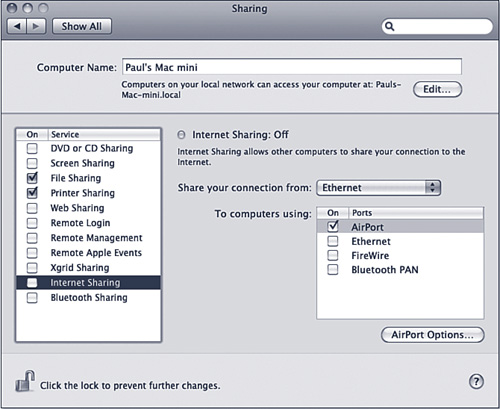
3. Select the Internet connection you want to share with other machines on the Share Your Connection From pop-up menu. For example, if your computer gets its Internet connection from a wired network, select Ethernet.
4. Select the type of connections with which you are going to share the machine’s Internet connection by activating the appropriate To Computers Using check boxes. For example, if you want to share the connection with computers via AirPort, check AirPort, and if you want to share the connection via FireWire, activate the FireWire check box. You can choose more than one connection type with which to share the connection.
Note
![]()
You can choose to share a connection from a wired network to AirPort-equipped machines or from an AirPort-equipped machine to a wired network.
5. If you share the connection over AirPort, select AirPort and click the AirPort Options button. The AirPort network configuration sheet appears.
Note
![]()
WEP is an encryption strategy that attempts to provide wireless networks with the same level of protection that wired networks have. WEP does provide improved security compared to nonencrypted transmissions, but be aware that it does have some flaws as do almost all security measures. If the information transmitted over your network is very sensitive, you should use WEP to provide at least some protection.
6. Edit the default network name as needed. The default name is the name of your computer, but you can make it something more interesting if you want to.
7. Unless you have multiple AirPort networks active in the same area or you experience interference that prevents your network from operating properly, leave the Channel pop-up menu set to Automatic. If you want to choose a channel manually, select it on the pop-up menu.
8. For a more secure network, check the Enable Encryption (Using WEP) check box.
9. Enter the network password in the Password and Confirm Password fields. This is the password users will enter to connect to the network.
Tip
![]()
If you’ll be sharing the network with computers not running Mac OS X, make sure the password you create is 13 characters if you use 128-bit encryption or 5 characters if you use 40-bit.
10. Select an encryption key length on the WEP Key Length pop-up menu. The options are 40-bit and 128-bit. If only newer Macs running Mac OS X will be connecting to the network, select 128-bit. If you aren’t sure which level of encryption other machines can support, select 40-bit. If you don’t want to use the encryption at all, uncheck the Enable Encryption (Using WEP) check box.
Tip
![]()
If Printer Sharing is enabled, USB printers connected to the Mac acting as a base station are also available to the AirPort network. This is a great way to share USB printers with other Macs. Also, the AirPort menu on the menu bar on a Mac acting as a base station is different than the menu on a client machine. This menu also has different options than a client menu.
11. Click OK. The Options sheet closes.
12. Check the Internet Sharing check box and then click Start when Mac OS X asks you to confirm. The Internet connection is shared with other computers via AirPort or built-in Ethernet.
13. Use the Other Services check boxes to configure other services you will provide over the network, such as File and Printer Sharing. Your Mac then begins providing services over AirPort and its network becomes available to AirPort-equipped Macs.
![]() To learn how to control sleep, see “Managing Your Mobile Mac’s Power,” p. 549.
To learn how to control sleep, see “Managing Your Mobile Mac’s Power,” p. 549.
Connecting to an AirPort Network with Mac OS X
After an AirPort network has been established, you can access it from any AirPort-equipped Mac.
To access an AirPort network, you must configure a Mac OS X machine to connect to it.
You can do this in several ways. For example, you can configure a Mac’s Airport using the AirPort tools on the Network pane of the System Preferences application, by completing the following steps:
1. Open the System Preferences application and click the Network icon to open the Network pane.
2. Click the AirPort option in the left part of the pane. The AirPort tools appear in the right part of the pane.
3. If AirPort is currently off, turn it on by clicking the Turn AirPort On button. AirPort services start. If your Mac has connected to a network, you see information about that network at the top of the pane.
4. To join a network, select the network’s name on the Network Name pop-up menu and enter the password if the network requires one. The Mac joins the network (see Figure 18.8) and starts receiving services over the network.
Figure 18.8 Use the AirPort tools to configure how your Mac connects to AirPort networks.

5. If you want to be prompted to join new networks, activate the Ask to Join New Networks check box.
6. Activate the Show Airport Status in Menu Bar check box to put the AirPort menu on your menu bar. You can use this menu to quickly select and control your AirPort connection.
7. Click the Advanced button. You will see the Advanced options sheet, which you can use to configure additional aspects of your AirPort connection. It’s unlikely you’ll ever need to use most of these options, but they enable you to configure specific aspects of your connection, such as your preferred networks and the TCP/IP settings.
Note
![]()
As your Mac connects to the network, the name of the network to which you are connecting briefly appears next to the AirPort icon in the menu bar.
8. Click OK to close the Advanced sheet.
9. Click Apply and quit the System Preferences application.
If you want to use an AirPort network other than your preferred one, open the AirPort menu on the menu bar and select the AirPort network to which you want to connect. If its password is not already stored on your keychain, you will be prompted to enter it. Do so and you will be logged on to that AirPort network.
Tip
![]()
When prompted to enter your password, activate the Add to Keychain check box to have Mac OS X remember the password so you don’t have to enter it again.
You can use the AirPort menu on the menu bar to control AirPort in several ways, including the following:
• Measure the signal strength of the connection—The “waves” emanating from the AirPort icon show the relative strength of the signal your Mac is receiving. As long as you see two or more waves, the signal you are receiving is plenty strong.
Note
![]()
If you can access an AirPort network but can’t access the Internet, see “I Can’t Access the Internet Through AirPort Even Though I Can Connect to the AirPort Network” in the “Troubleshooting” section at the end of this chapter.
• Turn AirPort on or off—You can disconnect your Mac from the AirPort network and disable AirPort services by selecting Turn AirPort Off. Turn AirPort on again by choosing Turn AirPort On.
• Choose a different AirPort network from the list of available networks—When you do so, you are prompted to enter the password for that network—unless you have saved the password to your keychain. Do so and you will move onto to the network you select.
Note
![]()
Some AirPort networks are hidden (a closed network) and do not broadcast their identities. To join such a network, you must know the name and password of the network you want to join. To join a hidden network, select Other on the AirPort menu on the menu bar, enter the name and password for the network, and click OK.
• Create a computer-to-computer network—When you select Create Network, you can create a network between two or more AirPort-equipped Macs. In the Computer to Computer dialog box, enter the name and password of the network you are creating, select the channel you want to use, and then click OK. Other users can select the network on their AirPort menus (of course, you need to provide the password for your network to those users if you require one). When your Mac is hosting a computer-to-computer network, the AirPort icon changes to a Mac “inside” a quarter circle to show that you are in the computer-to-computer mode.
The Channel you choose for a network controls the frequency of the signal used to create an AirPort network. If you have trouble connecting to other machines over the network you create, try a different channel.
When you create and use a computer-to-computer network, other AirPort connections, such as the one you use to connect to the Internet, are deselected and therefore can’t be used.
Tip
![]()
Computer-to-computer networks are a great way to play network games. You can create an AirPort network and host a game. Other users can connect to the network and join the game by selecting your network using their AirPort controls.
To require and configure a password for the network, click Show Options in the Computer to Computer dialog box.
Check the Use Interference Robustness check box to make the network less susceptible to interference (it will have a smaller range).
Using AirPort is a great way to quickly create and use wireless networks. After you have connected to the Net without wires (especially when roaming with a mobile Mac), you won’t want to settle for anything else.
Note
![]()
If you are getting no signal or a weak signal from the AirPort network you want to join, see “Weak Signal” in the “Troubleshooting” section at the end of this chapter.
Although this chapter has focused on using AirPort to access the Internet, an AirPort connection works just like any other network connection (such as an Ethernet connection). For example, you can access the files on another machine over an AirPort network just as you can with an Ethernet network.
Troubleshooting Your Wireless Network
Wireless networking is notoriously finicky to configure, and equally notoriously flaky to connect. (The major exception is the AirPort Extreme base station, which I’ve found to be gratifyingly easy to configure and amazingly reliable.) If you’re having trouble with wireless networking, the next few sections offer some solutions.
No AirPort Hardware Is Found
When I launch the AirPort Utility, I see an error message stating that the required AirPort hardware can’t be found.
If you have recently plugged in your AirPort base station, it usually takes a few minutes for the initial startup to complete, so wait a bit and then click Rescan to try again.
The AirPort software requires that you have an AirPort card installed on the machine you use to configure a base station. If an AirPort card is not found, the software won’t run.
If you don’t have an AirPort card installed in your Mac, you need to install one before running the AirPort Setup Assistant.
If you do have an AirPort card installed, it is not properly installed. Repeat the installation steps to ensure that the card is properly installed.
I Can’t Configure My Base Station Manually
When I try to configure a base station manually, I get an error stating that the base station can’t be configured.
This problem can occur for various reasons. First, try resetting the base station (see the next section). If that doesn’t work, try opening the AirPort Setup Assistant and configuring the base station using the assistant. Then, go back into the AirPort Admin Utility and try to configure the base station again. This sometimes clears the error.
I Don’t Know the Base Station Password
I can’t access the base station because I don’t know its password.
When you have trouble with an AirPort Base Station, you can reset it to its factory defaults by inserting a paper clip into the reset button hole on the bottom or back of the unit. Hold down the button for 5 seconds and the base station is reset—all settings are returned to the default and the password becomes public.
Weak Signal
My AirPort signal strength is low. Or, I can’t find the network to which I want to connect.
Two primary factors affect the strength of the AirPort signal your Mac receives from a base station (hardware or software) or from Macs providing a computer-to-computer network. One is the distance from the base station to your Mac; the other is the amount of interference in the area.
If your Mac is within range of the base station you want to use, there should be no trouble getting a strong enough signal. If you are at the edge of or beyond that range, move your Mac closer to the base station or move the base station closer to you. You can also try repositioning the base station, because it can sometimes be affected by materials or other fields between it and your Mac.
If you are close to the base station but can’t get a strong signal, try changing the frequency of the network in the event that it is being interfered with by another signal of some type.
![]() To learn how to change an AirPort network’s frequency, see “Configuring a Base Station Manually,” p. 393.
To learn how to change an AirPort network’s frequency, see “Configuring a Base Station Manually,” p. 393.
I Can’t Access the Internet Through AirPort Even Though I Can Connect to the AirPort Network
My Mac is connected to an AirPort network, but I can’t access the Internet.
If you are connecting to the Internet through a base station, the most likely cause is that the base station has lost its Internet connection. Use some means to confirm that Internet services are available to the base station, such as by using a machine connected independently or calling your service provider. If services are available, use the AirPort Admin Utility to check its configuration to ensure that it is correct. If all else fails, reset the access point.
If none of these steps works and you have a broadband modem connected to the base station that provides DHCP services, use the following steps to attempt to reset the connection:
1. Unplug the modem for at least 20 seconds, and then plug it back in again. This forces the modem to get a new address.
2. Reset the base station by pressing its reset button for 5 seconds.
3. Open the AirPort Setup Assistant and select the Join an Existing Network option.
4. Follow the onscreen instructions to update the base station.
